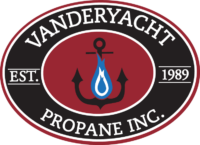- To determine how much propane is needed during an emergency, consumers need to know what appliances or equipment they are fueling and the BTU rating for each item. Appliance BTU ratings can be found on the appliance or in the owner’s manual. The rating is the number of BTUs that are consumed by the appliance during a one-hour time period. A typical 20-pound barbecue grill cylinder contains about 430,960 BTUs, so calculating usage is relatively easy. Here are some examples:
- 40,000 BTU rating: The cylinder should fuel this appliance on a high setting for over 10 hours of continuous use.
- 60,000 BTU rating: The cylinder should fuel this appliance on a high setting for over seven hours of continuous use.
- Most cooking is done by starting on high and preheating the grill, and then turning the burner to medium or low for cooking, which will affect usage time.
SAFETY TIPS: BEFORE THE STORM
- Properly secure the propane tank, if possible.
- Never bring a propane tank indoors.
- Turn off the gas supply valve at the tank.
- Fasten the protective dome on the tank.
- Turn off appliance pilot lights, control valves, and manual shutoff valves.
- Ensure an adequate supply of fuel is in the tank.
SAFETY TIPS: AFTER THE STORM
- Propane consumers returning to their homes and businesses after a hurricane should be on the alert for the following conditions and contact their propane dealer or qualified technician for repairs
- Visible structural tank damage; including external appliance venting and vent caps.
- Propane tanks that have shifted or moved.
- Broken, bent or otherwise damaged gas lines.
- Appliance controls or appliances that have been exposed to water.
- Tank regulators that have been exposed to water.
- Never attempt to make repairs yourself or to use appliances or equipment if any of these conditions exist.
- Have any appliances or equipment damaged or exposed to water inspected by a licensed gas supplier or technician prior to use.
- Do not use any type of equipment fueled by gasoline, propane or other fuel indoors as they may produce hazardous carbon monoxide.
- If you did not turn off the gas tank prior to evacuation, do so before turning on any electrical service or attempting to use any device that may generate sparks or flames.
- If you smell gas, evacuate the area and call your propane supplier and/or emergency respondents immediately.
